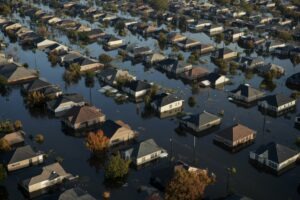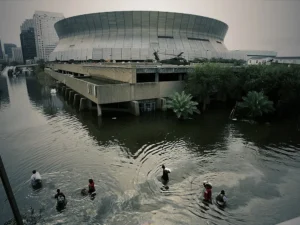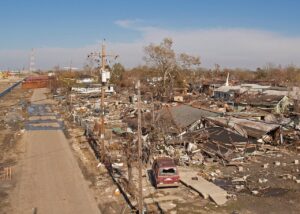20 Years Later: Hurricane Katrina and the Evolution of Crisis Communication
Published on October 23, 2025, at 11:50 a.m.
by Mallory Magee
Water rose through the streets of New Orleans, flooding neighborhoods and forcing residents to seek higher ground. Hospitals scrambled to continue caring for patients, emergency teams worked under extreme pressure and communication broke down entirely. In the chaos, people climbed onto rooftops, waved for help and waited not just for rescue, but for information. Radios were silent. Phones were dead. The city wasn’t just drowning in water—it was drowning in silence.
When Hurricane Katrina made landfall in New Orleans on Aug. 29, 2005, it completely overwhelmed the city’s infrastructure. Power outages shut down radio and television broadcasts, while collapsed cell towers and damaged landlines left nearly three million customers without phone service. In addition, 911 emergency call centers were destroyed, which disrupted local emergency services. For days, many residents had no way to access reliable information about shelters, food or medical assistance. The failures in levees and infrastructure are widely remembered, but less visible—and just as critical—was the collapse of communication.

The people who stood on those rooftops 20 years ago witnessed a storm that not only changed the city of New Orleans forever but also redefined how public relations professionals, hospitals and government agencies approach crisis communication. On this anniversary, Katrina serves not only as a reminder of the storm’s physical devastation but also as a guide for how organizations respond to crises and how far PR strategies have evolved since.
“Communication was absolutely crippled by Katrina,” says Melissa Hodgson, the director of communication at St. Tammany Parish Hospital during the storm. The hospital itself was prepared with generators, wells and supplies, and Hodgson’s responsibility quickly became to communicate that it was up and running and capable of taking care of people. To do so, however, was a challenge. “We were using police radio. We would drive toward Baton Rouge until we got a signal, then stop and make a bunch of phone calls to handle hospital business,” she recalls.
Hodgson’s experience illustrates a critical takeaway: redundancy in communication is essential, and so is understanding the channels that carry your message. Too often, public relations professionals focus on crafting the right statements for their audiences, yet they overlook the infrastructure that delivers those messages. Katrina revealed that even the best crisis plans can fall apart if the infrastructure supporting communication collapses.

After the storm, St. Tammany Parish Hospital made major changes to ensure its communication systems would never again be so vulnerable. The hospital updated its policy to include communication directors as part of the core emergency response team and diversified its networks by adding satellite connections, multiple providers and eventually fiber-optic lines to avoid relying on a single technology. According to Hodgson, these shifts were about knowing each channel’s strengths and weaknesses, how to pivot between them under pressure and how to reach your audience no matter the circumstances. “You can be as prepared as possible, but that no longer matters if the technology to carry your message is crippled,” she says. “It’s not just about what you need to say and who you need to say it to; it’s understanding enough about those channels of communication to make sure you can get your word out.”
The storm also highlighted the consequences of inconsistent messaging on a larger scale. Lauren Conrad, who has served as senior communications manager at the Louisiana Public Health Institute and as director of public relations for Audubon Nature Institute in New Orleans, reflects on Katrina’s broader lessons and how the storm reshaped the field of crisis communication. With experience in both public health and organizational communications, she understands the critical role that clear messaging plays when lives are at stake.
“There was a cataclysmic breakdown of all communication services, combined with disjointed and sometimes contradictory messages between federal and state governments,” she says. Residents depended on media coverage for survival information, such as shelter locations, supply distribution and evacuation routes, but often received conflicting or delayed updates. As a result, the importance of unified messaging and the need for a centralized communication plan were learned.
Additionally, misreporting and inaccurate portrayals of victims further complicated issues. For example, multiple stories of rampant violence at the Superdome and Convention Center circulated nationally and were later proven false. For journalists, Katrina underscored the importance of fact-checking in real time, and for public relations professionals, it highlighted the necessity of working closely with the media to ensure the public received accurate information.

Since 2005, crisis communication has significantly evolved. Today, social media allows organizations to share real-time updates that provide immediacy—something traditional press releases were unable to achieve. Hodgson notes that the hospital became an early adopter of social media, using platforms like Facebook to inform the public of operational changes and keep residents safe. While she explains that social media can be useful if what you’re sharing is productive and accurate, she also warns that it can cause harm if people share inaccurate or sensitive information.
Another point Conrad emphasizes is that public relations professionals must balance urgency with accuracy when managing communication in a crisis. “PR professionals need to get ahead of questions and chatter while ensuring that what they are delivering is fact, not hearsay,” she says. “They need to keep opinions out of a situation like Katrina, understand that it was a life-or-death situation for the people living in the area, and report only the necessary information—not sensationalized stories.”
Proactive planning and preparation, according to both Hodgson and Conrad, remains the foundation of effective crisis communication. “You want an assortment of prepared strategies,” says Hodgson. “Having everything scripted can make responses feel stilted and disconnected from the actual situation, so think about likely scenarios, your audiences, and the information they would need in any type of emergency.”
Twenty years later, Hurricane Katrina stands as both a tragedy and a teacher. Its communication failures pushed hospitals, government agencies and public relations professionals to rethink how they prepare for and respond to crises. The core takeaways—redundancy, accuracy and urgency—remain just as vital today, guiding responses not only to hurricanes but also to pandemics and other emergencies. Katrina serves as a lesson on how effective crisis communication can save lives, provide clarity and strengthen preparedness. As Conrad sums it up, “The goal is to get ahead of disasters, not fall behind.”




